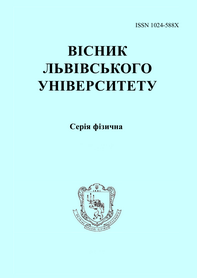Visnyk of the Lviv University. Series Physics
57 (2020) ñ. 122-131
DOI: https://doi.org/10.30970/vph.57.2020.122
Peculiarities of positioning of electronic states 4f and 5d of Pr ionin the matrix LaF\textsubscript{3}
V. Karnaushenko, Ya. Chornodolskyy, V. Vistovskyy, S. Syrotyuk, A. Voloshinovskii
|  |
The LaF3:Pr crystal is known for the presence of photon cascade emission (PCE), that isn't characteristic for other crystals of the LaX\textsubscript{3}:RE (X = F, Cl, Br, I; RE = Ce-Lu) group and is consequence of the relative location of 4f and 5d Pr\textsuperscript{3+} energy levels. For a better understanding of the photon cascade emission mechanism and laser properties of the crystal, a theoretical study of the electronic energy structure of LaF\textsubscript{3}:Pr has been provided to analyse partial and total densities of states of the crystal, its electronic band structure and effective mass of an electron at the bottom of conduction band near à point. All calculations have been done within density functional theory (DFT) using Abinit software. To describe the fast-oscillating components of wave functions near the core levels, the projected augmented wave (PAW) method has been used with an energy cutoff of 861 eV on a Monkhorst-Pack grid of size 8x8x8. Peculiarities of strongly localized 4f and 5d orbitals of lanthanide ions were taken into account by introducing Hubbard corrections with parameters: U = 2.1 eV and J = 0 eV. From the obtained theoretical results, it has been concluded that the valence band is formed by 2p F states, and the conduction band bottom is formed by 5d La levels, below which 5d Pr states are placed. The 4f Pr states are characterized by high intensity and distributed around the band gap center. The width of the 2p F band is 3 eV. The energy difference between the lower and upper levels of 4f Pr\textsuperscript{3+} is 4.4 eV and between 2p F\textsuperscript{-} and lowest 4f Pr\textsuperscript{3+} is 2.1 eV. The crystal field splitting for 5d Pr levels is 1.4 eV with the centroid at 8.67 eV. The calculated energy band gap is 9.6 eV, and the resulting effective mass is 0.33m\textsubscript{0}. The obtained from calculation mutual arrangement of the 4f and 5d levels of impurity ions Pr\textsuperscript{3+} is such that only f-f luminescence can be observed, which provides the observation of photon cascade emission.
Full text (pdf)
References
- Dujardin, C. et al. Needs, trends, and advances in inorganic scintillators. IEEE Transactions on Nuclear Science 65.8 (2018): 1977-1997, doi: 10.1109/TNS.2018.2840160.
- Rodnyi, P. A., A. S. Potapov, and A. S. Voloshinovskii. Spectral and kinetic characteristics of trivalent praseodymium in LaF\textsubscript{3}-LiF and SrAl 12 O 19. Optics and spectroscopy 96.6 (2004): 862-868, doi: 10.1134/1.1771420.
- A.M. Srivastava. Aspects of Pr\textsuperscript{3+} luminescence in solids. Journal of luminescence 169 (2016): 445–449, doi: 10.1016/j.jlumin.2015.07.001.
- Carnall, W. T., P. R. Fields, and R. Sarup. \textsuperscript{1}S\textsubscript{0} Level of Pr\textsuperscript{3+} in Crystal Matrices and Energy Level Parameters for the 4f\textsuperscript{2} Configuration of Pr\textsuperscript{3+} in LaF\textsubscript{3}. The Journal of Chemical Physics 51.6 (1969): 2587-2591, doi: 10.1063/1.1672382.
- Dorenbos, Pieter. Ce\textsuperscript{3+} 5d-centroid shift and vacuum referred 4f-electron binding energies of all lanthanide impurities in 150 different compounds. Journal of Luminescence 135 (2013): 93-104, doi: 10.1016/j.jlumin.2012.09.034.
- Jain, Anubhav, et al. Commentary: The Materials Project: A materials genome approach to accelerating materials innovation. Apl Materials 1.1 (2013): 011002, doi: 10.17188/1272758.
- Momma, Koichi, and Fujio Izumi. VESTA: a three-dimensional visualization system for electronic and structural analysis. Journal of Applied Crystallography 41.3 (2008): 653-658, doi: 10.1107/S0021889808012016.
- Adamo, Carlo, and Vincenzo Barone. Toward reliable density functional methods without adjustable parameters: The PBE0 model. The Journal of chemical physics 110.13 (1999): 6158-6170, doi: 10.1063/1.478522.
- Himmetoglu, Burak, et al. Hubbard corrected DFT energy functionals: The LDA+U description of correlated systems. International Journal of Quantum Chemistry 114.1 (2014): 14-49, doi: 10.1002/qua.2452.
- Karnaushenko, V., et al. Electronic energy structure of LaF\textsubscript{3}:Ce crystal. Visnyk of the Lviv University: Series Physics, 56 (2019) p. 133-139, doi: 10.30970/vph.56.2019.133.
- Karnaushenko, V., et al. Energy band structure of LaF\textsubscript{3}:Sm and LaF\textsubscript{3}:Pm crystals. Journal of physical studies, v. 24, No. 4 (2020): p. 4, doi: 10.30970/jps.24.4703.
- Liechtenstein, A. I., Vladimir I. Anisimov, and Jan Zaanen. Density-functional theory and strong interactions: Orbital ordering in Mott-Hubbard insulators. Physical Review B 52.8 (1995): R5467, doi: 10.1103/PhysRevB.52.R5467.
- Dudarev, S. L., et al. Electron-energy-loss spectra and the structural stability of nickel oxide: An LSDA+U study. Physical Review B 57.3 (1998): 1505, doi: 10.1103/PhysRevB.57.1505.
- Gonze, Xavier, et al. ABINIT: First-principles approach to material and nanosystem properties. Computer Physics Communications 180.12 (2009): 2582-2615, doi: 10.1016/j.cpc.2009.07.007.
- Blochl, Peter E. Projector augmented-wave method. Physical review B 50.24 (1994): 17953, doi: 10.1103/PhysRevB.50.17953.
- Topsakal, M., and R. M. Wentzcovitch. Accurate projected augmented wave (PAW) datasets for rare-earth elements (RE= La–Lu). Computational materials science 95 (2014): 263-270, doi: 10.1016/j.commatsci.2014.07.030.

